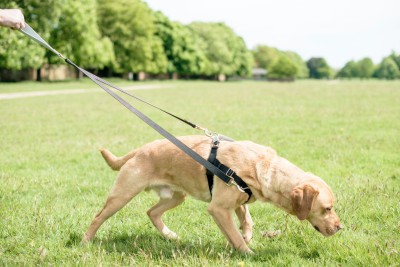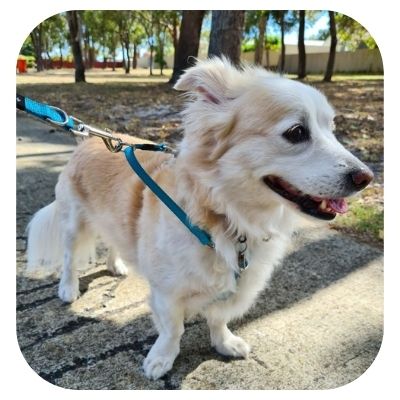 You’ve bought a no-pull harness and yet your dog still pulls! What was supposed to be a magical solution to your pup’s tugging and dragging hasn’t lived up to your dreams of relaxed, stress-free loose leash walking.
You’ve bought a no-pull harness and yet your dog still pulls! What was supposed to be a magical solution to your pup’s tugging and dragging hasn’t lived up to your dreams of relaxed, stress-free loose leash walking.
In this situation, it’s easy to see why many of us pet parents can feel frustrated or perhaps even cheated about the claim of a particular harness being ‘no-pull’, especially when our dogs continue to pull when walking. However, here’s one thing you need to know about no-pull harnesses…
As much as they’re designed to help reduce or deter this behaviour, they’re never going to be 100% effective without you also undertaking some training with your pup.
There may be many reasons why your dog is still pulling on their no-pull harness; whether it’s because they’re extremely excited to be out exploring the big wide world with you, they see another dog across the park that they’re really determined to go say ‘hey there friend!’ to, or for more serious reasons like fear or reactivity.
What remains the same across each scenario is that you’re only ever going to be able to prevent your dog’s pulling by first addressing their instinctive response to these external stimuli.
In other words, you’re going to need to do some positive reinforcement training that makes their default response to any excitement or stress be to look to you for direction and guidance.
But before we dive into our top advice to prevent your dog from pulling on a no-pull harness, it’s important to understand…
If you’ve done any research at all around dog harnesses you’ll already be aware of the danger of pulling on a leash too hard. A vital function of a dog harness is to take away the pressure and tension on a dog’s neck, preventing any choking or danger of injury, whilst also affording us pet parents greater control and security when taking our pups for a stroll.
But what actually is a no-pull dog harness and, in the same vein, how does a no-pull leash work?
In short, a no-pull harness is a harness specifically designed to help prevent or minimise any dragging. Most no-pull dog harness designs involve straps that cross key areas of your dog’s shoulders, chest and behind the front legs. For these designs, thicker straps help to prevent rubbing or chafing, so make sure to look for this in your no-pull harness too.
More often than not, no-pull harnesses will also feature a front and back ring, giving you the option to clip a lead to the chest, back or both.
The benefit of the front ring is that when a leash is clipped here, it can help to more easily redirect your dog’s momentum so that if they do drag or pull forwards, that movement is steered round instead. Additionally, having both a front and back ring means you can increase or decrease pressure where needed, affording you greater control over their movements.
(Remember, when dogs experience tension on a lead this can increase stress levels or even encourage pulling. So where possible try not to drag or pull on your leash either and instead focus on training your dog for loose-leash walking, which we’ve written a blog on here.)
Overall, if looking at it from a standpoint of a no-pull dog harness vs regular harness, a no-pull dog harness will typically offer the following benefits:
As we mentioned previously, the only way to completely prevent your dog from pulling on a no-pull harness is to train them for loose leash walking. You need to shape her behaviour to understand that you’ll only move forwards when the leash is loose, not taut, and she’s standing relaxed by your side.
In situations where your pup does begin to pull, you can adopt either two responses:
You’ll need to repeat either option each time the dog pulls.
You might feel a bit silly at first, constantly stopping or doing u-turns, but this is what will ultimately teach your dog to watch for your signals, read your body language and match your pacing. You’re deciding what direction or speed you’re walking, not them.
Also, don’t be discouraged if their pulling seems to improve, only to regress the next time you go out. This is totally normal and you’ll just need to give your pup a reminder by once again following Option A or B.
Positive reinforcement training is all about rewarding your dog for making good choices. Remember to reward them for walking to heel or following your change of direction, whether that’s with verbal praise, a treat or other reward.
Also don’t forget to make use of your front and back harness rings. These can help you in communicating with your dog what direction you want them to walk.
Most times, our pups are desperate to please us, so the clearer you can be in your communication the easier it will be for them to meet our requests.
 Top 5 No-Pull Dog Harnesses
Top 5 No-Pull Dog HarnessesNow that you understand all the amazing benefits a no-pull harness can offer, and also how positive reinforcement training will make it truly effective, you might next be wondering what no-pull dog harness is best for your dog. Or even whether you should upgrade your harness to another brand, to better meet your pup’s needs.
In that case, I wanted to offer my top no-pull dog harness recommendations, to support your loose leash walking training:
When it comes to selecting a no-pull harness, my recommendation is to think about what your dog’s specific physical and behavioural needs are, and also what environments you’ll be walking your dog in.
Your dog’s safety, security and comfort should always take priority in any harness design, which is why I created the 4Pooch Control Harness - made even more effective when paired with the 4Pooch Multi-Function Lead. With these two tools to hand, I’m confident walks with your beautiful pup will become an absolute breeze in no time at all.
I hope you found this blog on how to prevent your dog from pulling on a no-pull harness useful.
Remember to sign up for our newsletter for all our top training advice, plus any future product promotions!
A no-pull harness isn’t a fairy wand that will magically solve your dog’s pulling overnight, as it really comes down to how your dog responds to exciting or stressful situations. By engaging with loose leash walking training, using positive reinforcement methods, this will help to reshape your dog’s response to be from ‘Pull! Drag! Tug!’ to ‘What does Mum or Dad want me to do?’
It’ll take time to reach this point, but with persistence, patience and the correct equipment to hand, you’ll be sure to get there.
If you have any further questions on what no-pull dog harness is best for you, don’t hesitate to reach out. We’re always more than happy to help :-)